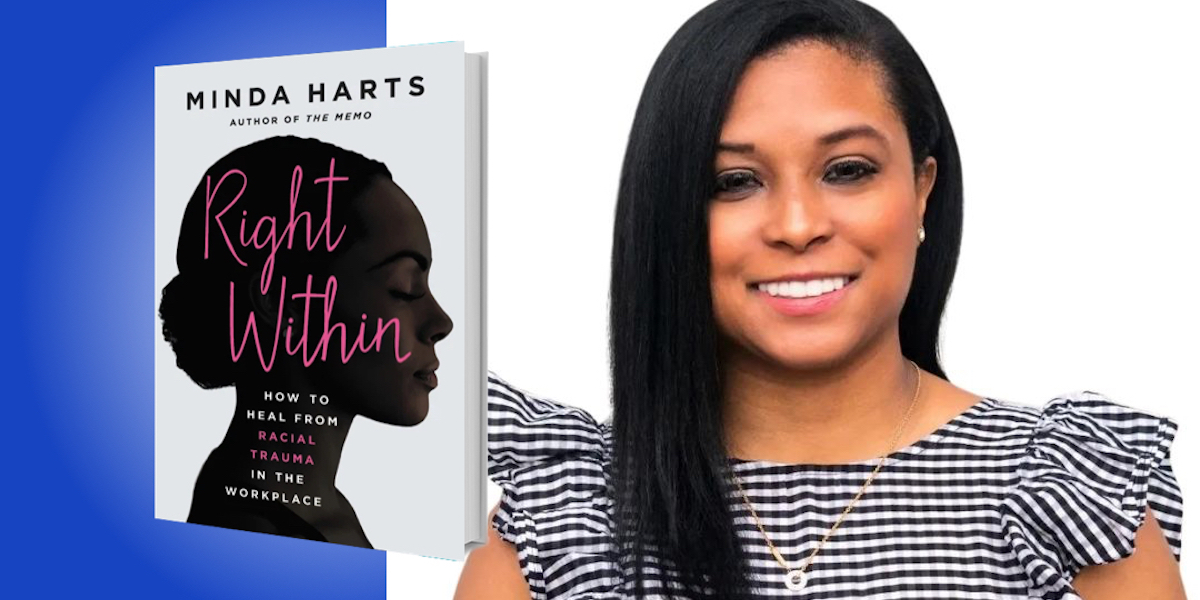Minda Harts is the CEO of The Memo LLC, a career development platform for women of color, a Professor of Public Service at NYU Wagner, and the author of The Memo. She has been featured on MSNBC’s Morning Joe and Fast Company, and speaks at Fortune 500 companies including Microsoft, Levi’s, and Google. In 2020 she was named a LinkedIn Top Voice, and in 2018, she was named one of 25 Emerging Innovators by American Express.
Below, Minda shares 5 key insights from her new book, Right Within: How to Heal from Racial Trauma in the Workplace. Listen to the audio version—read by Minda herself—in the Next Big Idea App.
1. The compounding impact of mental health challenges during the pandemic.
Recent studies show that right now, women and people of color are at greater risk for depression and anxiety. Racial trauma at work shouldn’t be part of the equation, but it often is. In my former life, I worked in corporate America in non-profit spaces for 15 years, and there wasn’t a day that went by that I didn’t experience some sort of racial discrimination. Imagine how taxing that is. Those micro- and macro-aggressions don’t just go away; they sit with us, and we sometimes experience them several times a day, even in virtual environments.
This year, a report came out saying that 54 percent of Black employees felt like they belonged at their companies for the first time while working from home. To me, that indicates that we have to talk about mental health as it pertains to marginalized groups in the workplace.
“54 percent of Black employees felt like they belonged at their companies for the first time while working from home.”
2. No more denial, no more walking on eggshells.
I spent the majority of my career being the only Black woman. And when you are in a situation like that, you feel isolated. So when someone says something to you that might be racialized, even though they might not have intended any harm, it still causes harm.
When I entered the workplace, my first manager saw that I had burnt orange fingernail polish on. He said in front of another colleague, “You people love your bright colors.” He went on to joke about Black people loving bright colors. I didn’t know what to say in that moment, and I honestly didn’t know if I could say anything, because I didn’t want the response to be, “Well, you took it the wrong way—I was just joking.”
After my manager said that, I no longer wore bright colors to the workplace, because he signaled that that wasn’t the type of authenticity that was welcomed in the office. So I was always walking on eggshells, making sure that I wasn’t different. I didn’t say anything, and I tried to adhere to the status quo. People may tell you to bring your authentic self to work, but what they really mean is, “Bring the version of yourself that we’re most comfortable with.”
You can’t do the best work of your career under that type of constraint, so it’s important that we don’t deny or dismiss those who identify differently than us. While you may never experience racism or sexism or any other form of discrimination, somebody else might. So what are we going to do to create psychological safety, ensuring that the workplace works for everybody?
“People may tell you to bring your authentic self to work, but what they really mean is, ‘Bring the version of yourself that we’re most comfortable with.’”
3. Faith, therapy, and introspection.
I interviewed faith leaders from various traditions, from Buddhism to Islam to Christianity, about finding strength in God and addressing the stigma that can come with seeking help from a therapist. When I was growing up, there was a lot of stigma around seeking help outside of the Church. Now, we talk about therapy a little more in a normalized sense, because we know that therapy is a tool for mental health. It may not be a tool for everybody, but it’s one tool that we can use if we’re experiencing discrimination or workplace trauma.
Personally, I decided that I wanted to seek out therapy, and I talk about how God can heal you on a couch, too. There’s no one-size-fits-all approach to healing. And healing is not a one-time event—it’s a lifestyle.
4. The affirmation pyramid.
Another tool for dealing with trouble in the workplace is what I call the “affirmation pyramid.” If you are the only one like you, you don’t have anyone to affirm that that situation shouldn’t have taken place. So you might start to question yourself, wondering if you made it all up—but at the end of the day, we all know when we’ve been disrespected.
“Healing is not a one-time event—it’s a lifestyle.”
There are five steps for using the affirmation pyramid:
- Pause: If somebody says something to you in an email or in person that is harmful, that you feel is racialized, take a moment. It’s okay to do that—you don’t have to pretend that nothing happened. We’ve been conditioned to sweep things under the rug, but it’s about time we put it on top of the rug so that we can get to equitable solutions.
- Acknowledge: When I was in my former life and something would happen, I would look for someone else to acknowledge that it was wrong. And when you’re not used to seeing accountability, it’s easy for people to dismiss it and say, “Well, I guess that’s just the way it is”—even if it hurts. But we can’t normalize bad behavior; we can acknowledge it ourselves.
- Document: You may not want to go tell your manager or go to a human resource department, but you can document the situation. If something has happened, or you find that meetings involve the most triggering racialized moments, go ahead and document that. That way, if at some point you decide that you do want to take it to HR or you do want to talk to your manager about it, you have it written down.
- Redistribute: It was very taxing for me to always be the only Black woman in the room. But instead of getting mad each time a racialized situation happens, I can choose how I want to use my energy—I can redistribute it into other places. It’s important to not let that energy marinate in your body, and cause you sickness or impede upon your mental health. You can redistribute that pain somewhere else, to a place that’s more positive.
- Affirm yourself: Sometimes you are the only one, and nobody else is courageous enough to admit wrongdoing or hold someone else accountable. But you don’t need them to affirm you—you can affirm yourself. It’s up to us to tell the truth. And when we tell the truth, that creates a more equitable workplace, and we can have more accountability—at least to ourselves, if no one else.
“We can no longer let managers or leaders opt into equity—it has to be mandatory.”
5. The manager’s pledge.
Oftentimes, people are promoted into manager positions, but they have no formal training on how to manage anyone. They have no conflict resolution skills. If they’re not comfortable talking about race, they choose not to, and they dismiss anything race-related. But we can no longer let managers or leaders opt into equity—it has to be mandatory. So I created a pledge that I hope all managers will commit to taking. Here are a few bullet points from it:
- I will acknowledge that I have biases that I need to understand and reconcile.
- I will commit to engaging in courageous conversations. They might sometimes be difficult, but I know they are necessary to create an inclusive workplace.
- Even if I make a mistake, I commit to the daily practices of being a better manager who is committed to equity for all.
If every manager commits to equity, then we are one step closer to creating an equitable workplace that is not harming women, people of color, or any other marginalized groups. Overall, I believe that we can make the workplace better than we found it.
To listen to the audio version read by author Minda Harts, download the Next Big Idea App today:
































